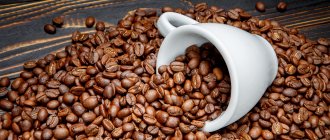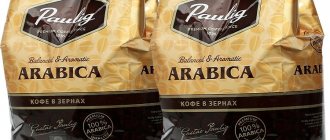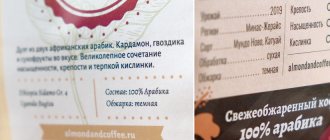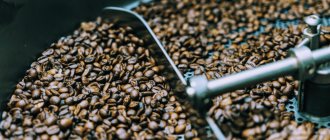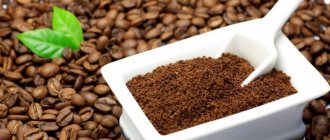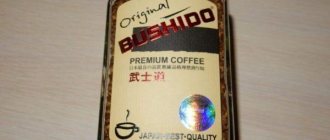Soft drinks
* The calculations use average data for Russia
At first glance, natural ground coffee may seem like a rather unpromising product for production: the market is represented by a large assortment, the raw materials for production are imported in any case, and sometimes even have gone through a rather long chain of resales; the manufactured product does not occupy such a large part of sales. However, after studying the issue more carefully, you can see that this is not the case at all.
The range of goods classified as elite does not affect demand at all. In fact, in this case the law of the transition of quantity into the ratio of quality and price works: lovers of natural coffee are well aware that in 90% of cases they overpay only for a well-known brand, and the quality of coffee (all other things being equal - preparation technology, source of raw materials and etc.) does not differ not only significantly, but not at all.
Therefore, the buyer will be more willing to purchase a package of good coffee from an unknown brand, but conscientiously approaching the issue of production, at a lower price than coffee - first, at least for testing, and then, having discovered a real opportunity to save, he will purchase this coffee constantly.
Mass consumers of coffee - cafes, restaurants and other catering establishments, as well as office managers involved in purchasing coffee for organizations, will be only too happy to reduce costs without losing quality. Therefore, at the initial stage, the main thing is to competently present your own product, even with a very small markup - the main thing here is not to make a big profit instantly, but to create a positive image of the product.
Then the price can be increased, making it equal or almost equal to others - out of habit, the consumer will still prefer your coffee.
Imported raw materials should not confuse you - in fact, in our country a huge number of enterprises work on imported raw materials: from construction work to the assembly of foreign-made cars in domestic factories from finished parts - almost everything produced in Russia in one way or another has some part imported raw materials and semi-finished products. This is a normal phenomenon in the economy, and no one went bankrupt precisely because of foreign raw materials - the cause of ruin can only be illiterate and ill-considered business management.
Regarding the coffee market segment in general from the point of view of natural coffee - yes, the ratio of sales of instant coffee to natural coffee is not in favor of the latter.
But we should not forget that the coffee market is growing, and with it the consumption of natural coffee is growing, displacing expensive (for example, freeze-dried) types of instant coffee, which, in turn, “squeezes” low-quality powder and ersatz brands out of the market.
In addition, there is the following statistics: in 2010, about 75% of the Russian coffee market was accounted for by instant coffee and coffee drinks, and the remaining 25% by natural coffee, but this share is gradually increasing. According to forecasts for 2011-2013, the average annual growth rate of natural coffee production in Russia will be 8%, instant coffee – 5%.
So the production of natural coffee is not only profitable, but also a very interesting business, which can eventually become the work of your whole life.
Primary processing of grains
It is divided into 2 types:
Dry processing of grains
This type of processing is considered the most ancient. Dry processing consists of scattering the fruits in a thin layer on the ground, brightly illuminated by the sun. Since the fruits have a fairly high moisture content, it is very important to constantly turn them so that they do not become damp and, as a result, become moldy. For the same purpose, they are covered at night. After 2 weeks, the pulp covering the grains becomes dry and turns brown, and the seeds inside dangle freely. This method is considered the most gentle for coffee beans. In some coffee-producing countries, the fruits are not collected, but are waited on the trees to dry, when they themselves fall onto a cloth specially spread under the trees. The fallen seeds are then sifted and cleaned.
Wet (wet) processing of grains
The essence of this method is that the coffee beans are not dried, but rather passed through a machine resembling a mill. The machine cleans in such a way that all the coarse pulp is removed, and the grain remains only in a thin shell. It is believed that this type of processing is a continuation of picking, when the raw materials are collected by hand, leading to practical uniformity of the grains.
After the pulp has been removed from the fruit using machines, the seeds are sent for washing, which takes place in channels specially built for this purpose. They are not made in the form of straight lines, but slightly twist. This allows you to better wash the grains and detect among them the diseased ones that begin to float up. This method of grain selection is considered the initial stage of sorting. After the grain is washed, it is sent for fermentation. This is done to remove insoluble particles of pulp remaining after washing. In order for the grain to pass through this stage normally, it is constantly turned over, exposing as much of the surface of the grain as possible to the sun. Typically, this stage lasts up to 24 hours. After this, the grain is sent for repeated washing. This method has become widespread relatively recently, as a result of which the coffee produced in this way is considered to be of very high quality. But this is a very expensive production technology because it requires large quantities of good quality water. But many coffee-producing countries do not have this opportunity. Therefore, some manufacturers use water several times to save money.
Of course, this significantly reduces the cost of work, but at the same time deteriorates the quality of the finished product. With repeated use of water, its acidity level increases significantly, which gives the finished product a very unpleasant taste and smell. Another disadvantage of the wet method is the risk of leaving at least a few beans in special pools designed for coffee fermentation. In this case, they will be fermented several times, which will ultimately ruin the entire batch of finished coffee. And this will not appear immediately, but only during the roasting process, when these grains begin to emit an unpleasant odor, spreading it to the grains of the entire batch.
Coffee beans - what is it anyway?
In fact, these are not grains, but berry seeds. The red or yellow berries grow on evergreen coffee trees. Plantations are located in equatorial or tropical regions - South and Central America, Africa, Asia. In April-August, coffee comes to the market from the Southern Hemisphere, and from September to March - from the Northern Hemisphere.
The taste characteristics of the final product directly depend on where the coffee grew. Plantation height, air and soil humidity, amount of precipitation, amount of sun - these are just a few “influencing factors”. As a result, batches of the same variety of coffee grown in different regions can taste very different.
Read more about the places where the best coffee grows here>>>
Of particular value is Arabica, which is grown in rather difficult climatic and landscape conditions, at an altitude of 800-2000 meters above sea level.
Roasting beans
Thermal type of roasting beans into 2 subtypes: contact and convective.
Thermal contact method
With the contact method, the grain is roasted by direct exposure to heat resulting from the contact of the seeds with the hot surface of the machine in which the roasting takes place. At the same time, the grain is stirred all the time so that it does not overcook. This subtype of roasting is considered the worst, since coffee is often over-roasted and the color of the beans is uneven, which deteriorates the quality of the finished product.
Thermal convective method
The convective method uses heated air, which enters the chamber where the frying process takes place. In this case, the grain is also subjected to constant mixing. The quality of the product resulting from this roasting method is significantly higher, since the grain is roasted more evenly; the grains have a uniform, uniform color - all this improves the appearance of the finished product.
Dielectric method
It is carried out using microwave energy, which penetrates deep into the coffee bean and roasts it. An important feature of this method is that the coffee beans do not come into contact with any heated surfaces at all, and this significantly increases its quality.
Radiation method
Today this is one of the newest and most advanced processing methods, which has not received significant distribution due to the high cost of the equipment, and also, most likely, due to prejudices associated with radiation. First, the coffee beans are illuminated with gamma rays and then roasted using standard heat treatment.
Coffee production equipment
The most affordable type of this business is the production of coffee beans, since it only requires:
- Roaster (apparatus for roasting grains). A roaster with a capacity of 10-25 kg per hour will cost from $3500.
- Installation for cleaning grains from debris.
- Apparatus for blending. Helps create blends from various varieties and types.
- Equipment for packing.
What does bean coffee production look like?
Video of the roaster in action:
The complete list of equipment for the production of granulated instant coffee differs very significantly: these are bunkers (containers) for raw materials and semi-finished products, and various scales, and vibration separators and coolers, vibrating screens, conveyors and elevators, granulators, pumps, drums for roasting beans, and many other devices.
Together, they form a coffee production line with a total value of about $3 million.
Prices for equipment using freeze dried technology range from $15 million to $40 million.
If the appropriate production facilities and other infrastructure exist, then the production of freeze-dried coffee will cost much less - only about $3.5 million.
What is an alternative?
An alternative is anything that allows you to make coffee without using a coffee machine. Alternative brewing methods tend to produce a less rich, dense brew, but often with a higher caffeine content due to a longer extraction time. For example, coffee brewed in a Turk, in a geyser or in a French press is also considered an alternative, but today more sophisticated methods are associated with this brewing method.
One of the most popular alternative brewing methods is Hario, or V60, or pour-over, which takes its name from the Japanese brand of the manufacturer. Essentially, coffee here is prepared using the drip method: a filter is placed in a special ribbed funnel, into which about 22 grams of coffee per 360 grams of water is poured, but, again, it all depends on your preferences or the barista’s recipe.
Similar to the brewing principle, the incredibly beautiful Chemex is a glass funnel that has been recognized as an outstanding piece of American design. As a rule, for a Chemex you use a slightly coarser grind than for a regular funnel, but the main advantage of this method is, of course, aesthetics and volume: in a Chemex you can brew up to a liter of coffee, depending on the size of the flask.
Another method using a funnel is wicket. This is most often a flat-bottomed metal funnel with holes in it to help ensure a more even extraction. More rare methods of brewing coffee are bonavita and clover; These funnels have a valve that allows you to adjust the extraction time.
One of the most popular alternatives is the Aeropress. A special device in the form of a flask allows you to extract coffee under pressure, while the device itself is quite miniature and can be taken with you when traveling. You can also prepare coffee in a siphon, but it is rare that a coffee shop undertakes this process.
Coffee does not have to be brewed with hot water. By the way, in alternative brewing methods the water temperature is usually lower than in an espresso machine, hovering around 96 degrees. You can also brew coffee with cold water; this method takes a little longer and is called cold brew. The Village has already written about how to brew coffee using an alternative method at home.
Rating of bean and ground coffee producers
Manufacturers of raw materials, as a rule, are engaged exclusively in exports, so companies that produce coffee for sale deserve special attention. Among them there are also undoubted leaders whose quality is trusted unconditionally. Producers of beans and ground coffee are large companies that have established contacts with various global suppliers of raw materials. Thanks to this, they can provide consumers with a wide range of products.
The best bean coffee producers:
Coffee Bushido Original and reviews about it
- Jardin - combines high-quality Arabica and Robusta, with varying degrees of roasting.
- Lavazza is a premium Italian brand with a delicate taste and moderate strength. The collection includes several blends.
- Paulig – coffee based on pure Arabica with high-quality dark roast. The range is represented by both premium blends and affordable options.
- Malongo is a French brand that produces expensive coffee with a deep taste without unnecessary impurities and a velvety aroma.
- Kimbo is an Italian manufacturer that has relied on traditional coffee taste without sourness or excess bitterness.
The Jardine brand is designed for wide consumption
The best manufacturers of ground drinks are almost the same brands as those of grain drinks. We can only supplement this list with several popular companies:
- Italian Camardo is quite tart, but not repulsive in taste. Ideal for preparing espresso-based drinks in a coffee machine.
- Illy is also from Italy. It is valued by Russian consumers for its delicate but deep taste and high-quality, first-class Arabica beans in its composition.
There are not many brands producing natural coffee in capsules, but there are leaders among them
Nespresso was a pioneer in the world of capsule drinks and has firmly established its position in the market. Its assortment includes 16 types of coffee, including decaffeinated. Cremesso is distinguished by its range of drinks, among which there are exotic varieties with the addition of spices. Nesсafe Dolce Gusto deserved third place in the rating. This brand has released capsules for preparing soft drinks with the addition of milk and cocoa.
Development prospects
If you start a coffee business, you can also start producing cocoa. In the manufacture of these two products, similar technological processes occur.
The second direction is our own chain of coffee shops. Own catering organizations mean an impressive increase in production, as well as a huge income that cannot be compared with wholesale trade: the price of a cup of coffee in any cafe is much higher than what you drink at home.
The third direction is the vending business. This is the placement of coffee vending machines (also called coffee machines) in crowded places, as well as vehicles specially equipped for the production and sale of the drink. At the moment, the coffee making machine is very popular, especially among young people. Therefore, there are many prospects for development, not counting the fact that we can simply increase production volume.
You can write a lot about this wonderful drink, but it is better to feel this unique aroma and understand the magic of tastes by trying a cup of brewed coffee.
Manufacturing options
The production of coffee (instant coffee, granules) is a complex process. Two methods of its manufacture are used. Initially, they resorted only to the high-temperature method, but recently the low-temperature method has been increasingly used. Each of these technologies has a number of features.
High temperature method
Instant coffee is produced using the following technology:
- Substandard beans, as well as leftover coffee products, are roasted and crushed. The resulting particles do not exceed two millimeters in size.
- The resulting product is filled with water and then processed under pressure of fifteen atmospheres. This process takes about four hours. The temperature is maintained at a high level all this time.
- At the next stage, the mixture is cooled, filtered and dried. In this way, it is possible to obtain a mass that looks like powder (the so-called powdered coffee).
- When used, the resulting product gradually clumps into lumps and sticks to the spoon. In order for it to acquire an attractive appearance, it is subjected to another stage of processing. The sublimate is churned into granules or processed with steam. Due to this, it is possible to avoid the collection of particles into dense formations.
- Only after this the product is finally dried.
It has been noted that granulated coffee looks much more attractive than powdered coffee. The particles do not stain dishes or stick to them.
Therefore, the cost of such products is higher, although in essence they contain the same ersatz powder.
Naturally, with prolonged exposure to high temperatures, grains lose their characteristic tart taste and pleasant aroma. To verify this, you can try boiling ground grains for three hours. It's unlikely that anyone will like this drink.
To improve the taste of the product, at different stages of production the extract is processed and various flavoring additives, oils and fragrances are sprayed. Freeze-dried and granulated coffee is additionally colored. Due to this, the particles acquire an attractive appearance.
Low temperature method
If instant coffee is produced using a low-temperature method, this process is carried out in several stages:
- First, the coffee beans are cleaned and crushed, after which they are treated with hot water under pressure.
- At the next stage, the resulting mass is deep frozen.
- The ice that is obtained is crushed and sent into a vacuum tunnel. There, the ice component evaporates, and the stage of water formation is passed.
The product that can be obtained by this method is called freeze-dried (dehydrated). The cost of such an ersatz is significantly higher. This is due to the fact that the technology is quite expensive. At the same time, the manufacturer manages to create significantly more finished products, which are subsequently sent for sale.
Expensive varieties are distinguished by the addition of oils and flavors of natural origin. They are obtained from coffee beans. Cheap varieties are produced using synthetic additives. In both the first and second cases, the raw materials are cheap varieties of beans, rejected material, and the remains of coffee production.
It is worth noting that the exact process of making instant coffee is classified. Therefore, it is impossible to know exactly what people actually drink under the guise of an instant drink.


